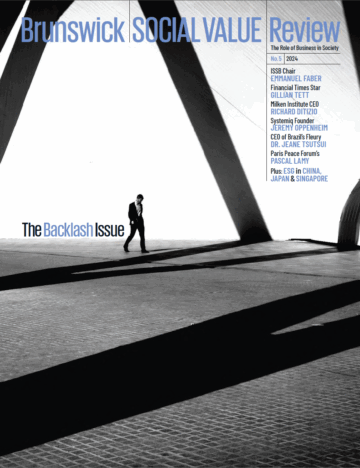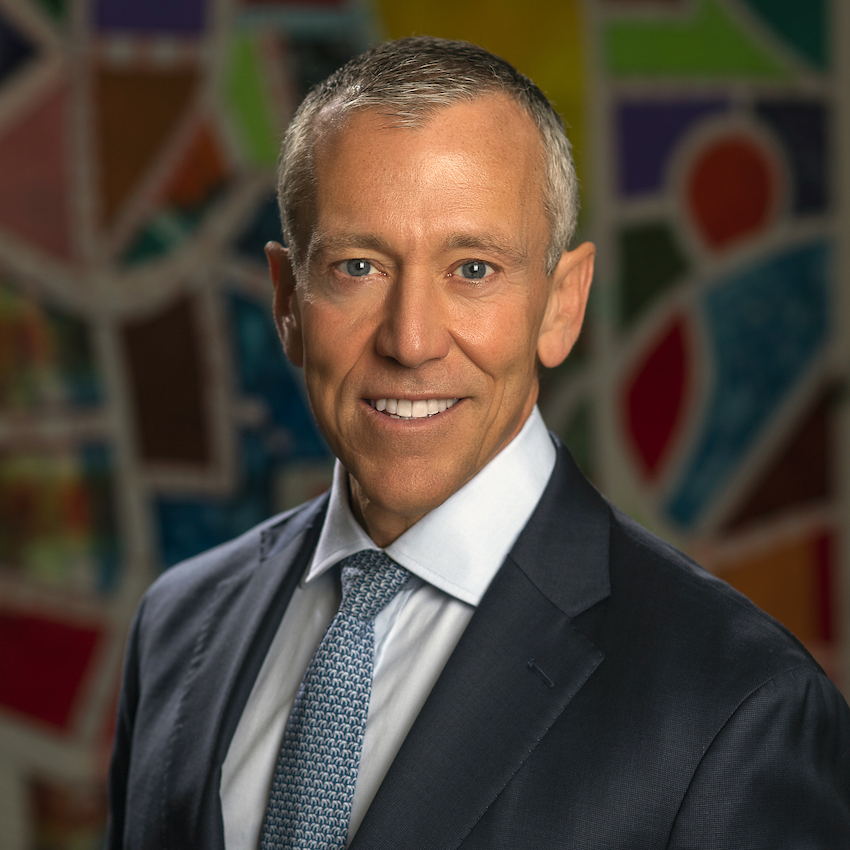A titan of business assumes the leadership of a sustainability nonprofit. By Pascal Lamy, Chair of Brunswick Europe.
After decades of bringing unity of standards to financial reporting around the world, the International Financial Reporting Standards Foundation was tasked to help establish a sister effort. At the COP26 gathering in Glasgow in 2021, the Foundation helped create the International Sustainability Standards Board, or ISSB.
In less than three years, ISSB has come a long way on its mission to standardize sustainability reporting around the world. To state what should be obvious, sustainability reporting matters no less than financial reporting. Weak financial reporting could be hazardous to investor financial security. Weak sustainability reporting could be hazardous to the future of humankind.
Chosen and recruited to serve as ISSB Chair is Emmanuel Faber who, during four years as Chairman and CEO of Danone, became famous for initiatives to combat climate change and inequality, including reporting a GHG emissions-adjusted earnings per share.
From an office in Frankfurt, Faber runs an ISSB board that has sister offices around the globe, including Beijing and Montreal. In June of 2023, the ISSB released its first two International Sustainability Disclosure Standards, the first covering “General Requirements for Disclosure of Sustainability-related Financial Information” (IFRS S1), and the second covering “Climate-related Disclosures” (IFRS S2).
In February, Faber participated in an interview with Brunswick Senior Advisor Pascal Lamy, who is Chair of Brunswick Europe and Vice President of the Paris Peace Forum. Faber discussed the progress, strategies and prospects for the ISSB. In describing sustainability as a new form of accounting, Faber said: “Financial accounting counts a lot of things, but not everything that counts.”
What keeps you running?
What keeps me going is the conviction that business doesn’t make sense unless it’s sustainable. That’s a belief I’ve held for 30 years, ever since I first became the CFO of a listed company at the age of 28.
The very first paragraph of ISSB’s first set of Standards says, “The value that a company creates for itself and for its shareholders is inextricably linked to the value that it creates, erodes or protects for others.” This is the new language of accounting. This is what keeps me running.
What kind of reception have the Standards met, IFRS S1 and IFRS S2?
There is a lot of traction. One month after the Standards were issued, they received the endorsement of the International Organization of Securities Commissions (IOSCO). IOSCO called the Standards fit for purpose and called for jurisdictions to adopt them. It has 135 members and encompasses 95% of the global market capitalization. IOSCO is also chairing our Monitoring Board, whose members include the EU Commission’s Vice President, the Chair of the US SEC, the Chinese Vice Minister of Finance, et cetera.
At COP28, our Standards were endorsed by a flurry of business organizations around the world representing more than 10,000 large companies. They were also endorsed by more than 70 individual investors, and investor membership organizations totaling $120 trillion worth of assets under management.
Less than six months after the IOSCO’s endorsement, the jurisdictions that are currently publicly consulting on draft standards based on ours, or have decided to adopt them, already represented close to 50% of global capitalization, excluding the US. From another angle, the 20-plus jurisdictions with which we are very actively engaged account for more than half of global greenhouse emissions.
“What keeps me going is the conviction that business doesn’t make sense unless it’s sustainable.”
To be clear, we do not impose standards on anyone. We propose the Standards for mandatory adoption by jurisdictions, and for voluntary use by companies and investors.
In the US, an SEC climate ruling is said to be coming soon. We have had regular exchanges with them. The SEC is very focused on avoiding the burden of multiple reporting for US companies. I would say that for US companies, there will be significant alignment between whatever climate rule will be issued by the US and what we do.
This widespread embrace isn’t surprising because the ISSB Standards, our products, are responding to market needs. We listened to about 30,000 people that we engaged with, and we received nearly 1,500 letters of comments during a four-month public draft exposure period. These exposure drafts were deeply important as we finalized what became the Standards.
The Standards have been published at a time when the mood of the public, as well as business and politics, has shifted. How do you explain this shift and does it influence your work at the ISSB?
During the last two years, events in some jurisdictions have certainly politicized the debate, and globally some of the dynamics have changed.
What hasn’t changed is the substance. I was in California last June when two large insurers announced they would stop issuing any new home insurance policies in the state because of floods and fires. As you know, Pascal, the banking system depends on insurance. It’s the basis for a loan.
Another example: Frankfurt, where my office is located, is 40 kilometers from the Rhine River, an essential trade route in Europe. Twice in recent summers, the Rhine ran nearly dry, and traffic had to be cut. That disruption caused inflation that we’re still paying for. In China, a factory employing hundreds of thousands had to close due to lack of water, to prioritize a nearby large city.
This is reality, not politics. Disruption of this kind is a growing factor in the value chains of companies. I find no CEO or CFO who is not aware that climate change is affecting business now. What I tell them is that my goal isn’t to save the planet. It’s to save business. It’s about creating business resiliency.
If there’s a bear in the forest running at you and your friend, you don’t have to outrun the bear. You just have to outrun your friend. Similarly, if your company’s climate resilience plan is better than your competitor’s, you will gain a cost-of-capital advantage. And that advantage will fund your transition.
But to do this, you need a language. As it stands, ESG metrics are reported in 500 different languages. The results are not assurable by auditors. They’re not reliable enough to make decisions. They’re not comparable. That’s why the ISSB is creating an assurable, bankable system that will allow for investor conversations about market/price allocation. There’s a need, now more than ever, for a language that describes sustainability in strategic terms, and that helps CEOs and CFOs develop more resilience.
“The day a climate report moves capital markets—this is what success looks like for us.”
Business leaders may know that their future success depends on ESG factors, but what if public opinion isn’t convinced?
About a year and a half into the backlash, you are seeing signs of the anti-anti-ESG backlash, wherein market participants are protesting about politicians restricting our freedom to use the asset manager of our choice. It’s back and forth.
But honestly, the train has left the station. California—a state with a GDP about the size of Germany’s—last year passed two climate bills, referencing ISSB Standards. Brazil has said ISSB Standards would be mandated from 2026. Turkey has said ’24. Japan said ’25. Singapore said ’25. Korea said ’27. Hong Kong is into it. The UK is currently debating it, as is Canada. At COP27, Nigeria became the first African nation to say, “I will adopt.” Kenya is currently looking at its adoption roadmap, along with various countries in Latin America and Southeast Asia. And the EU has adopted its own set of standards that are interoperable with ours.
When we speak to stock exchanges, the Tokyo Stock Exchange, the London Stock Exchange, they understand that there are negative externalities related to sustainability that aren’t reflected in a company’s valuation. Those negative externalities appear as beta and volatility in the market. By having a global language for disclosing vulnerabilities to, and hedges against, those negative externalities, we can reduce that beta and improve the reliability of the market. That’s why 60 different stock exchanges supported us at COP28.
Is the final purpose, in a nutshell, to change the metrics of value creation in global markets?
Of the need to build sustainability into valuations, Mark Carney said a long time ago: “You need two things to succeed: committed and courageous public policy, and well-informed capital markets.”
Success will come the day that climate reports are understood to contain value-changing information. The day a climate report moves capital markets—this is what success looks like for us. And climate is just the start.
The global value of listed bonds plus equity is $400 trillion. That’s four times the global GDP. If the global capital markets are informed with the metrics needed to make the right decisions, then those markets are the best ally of smart policy for transitioning towards more sustainable economics.
Are you optimistic that this system of standards will work?
We don’t have the luxury to be pessimistic. I was on stage recently when some young activists marched in and said what they had to say. Silence fell over the audience of about 1,000 people, and you could feel a certain nervousness, “What does this mean?”
From the stage, I said, “These could be my children or yours, actually. We have not convinced them that we are delivering a desirable future. That’s why they are here.”
Unless you believe that the next generation doesn’t count, you have to listen to what they have to say. It’s not that they know the truth. They probably don’t. But you don’t either. In that shared ignorance lies an opportunity to connect.
More from this issue

The Backlash
Most read from this issue

Milken Institute CEO Richard Ditizio




